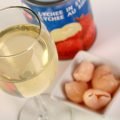Homemade Wildflower Mead

Mead - Honey wine - is easy to make from home, delicious, AND makes a great gift. This Homemade Wildflower mead is a unique, fun variation!
Mead is a fun, easy path into home wine making - at the base form, it’s just water, honey, and yeast.
Switching up your choice of honey is one way to vary the flavour of your finished mead, and - especially in the case of wildflower mead - you can always add more of those flavours to the brew!
Orange blossom honey can be accented with orange peel, blueberry blossom honey can be accented with the addition of blueberries, etc - mostly single note accent of the honey flavour that you start with.
With wildflower honey, though, you have a bigger playing field in terms of both the initial flavour of honey, AND what you add to it. The honey itself - and any flowers added - can produce a mead with surprisingly complex flavour and aroma notes.
First, a bit of info you'll need:

The Ingredients
Spring Water
We like to use a jug of spring water for this. It’s clean, easy, convenient, pre-measured, and won’t add any weird flavours to the mix.
While our water here in Hamilton is always clean and tasty, experience in Minneapolis showed us that that’s not always the case for everyone. Depending on the time of year, our water there would taste.. Vegetal.
Mold, algae, I don’t know... I just know that it wasn’t tasty, and I wouldn’t want to use it in this Homemade Wildflower Mead - or any other home wine making, for that matter.
We got in the habit of using a jug of spring water as the result of the inconsistency of water there, and it just stuck. If you tap water is consistently tasty and safe, feel free to use that instead of bottled.

The Honey
At its very base form, wildflower honey derives most - if not all - of the flavour from the honey you use, so be sure to get one you like!
Wildflower honey is honey that was made by bees that have been working on fields of wildflowers... and the honey takes on the flavours and aromas of the flowers that those bees were working on.
As such, “wildflower honey” can vary WILDLY in flavour, as the particular wildflowers closest to any particular apiary are going to be different from the wildflowers near apiaries in other regions.
Generally speaking, though, you can expect between mild and strong floral flavours from any brand of wildflower honey, with some having an almost fruity taste in there, as well.
Dutchman’s Gold is a local company that makes a great Wildflower Honey - and all kinds of other honeys - so they’re a great option for those that happen to be in Ontario - or Canada. (They do ship to the USA, too!).
No relationship to report there - it’s just the brand we use!

Use of Wildflowers
The use of wildflowers - in addition to wildflower honey - is entirely optional, and we usually don’t bother.
If you’re looking to add to the flavours of your wildflower honey, adding wildflowers to your mead is a great way to have more control over customizing the flavour to your liking. However, there are a few things to keep in mind:
Safety
First off, be sure to only use EDIBLE wildflowers. What edible flowers are available is going to vary wildly by region. Locally, violets, lilac, milkweed, dandelion, and goldenrod are all options.
I recommend googling “edible wildflowers *your area*”, and seeing what comes up. When you go to harvest some for your mead, be VERY SURE you’ve postively identified the flowers - call an expert if you’re not sure.
Secondly, be sure to only use wildflowers where you’re pretty sure there hasn’t been pesticide use on them. Even aside from safety - you CAN wash pesticide off, to a degree - it can screw with the flavour.
Your best option is to either use wildflowers you’re growing yourself - and know the treatment history of - or seek out something like a community garden or native plant restoration area, and see if they’re willing to let you pick a handful or two.
Last of all, consider allergies. Some edible wildflowers are allergy triggers for some people. Don’t use anything you - or anyone you’re serving it to - are allergic to.
While allergenic properties of wildflowers aren’t really an issue in wildflower honey itself, adding actual flowers to your mead is a whole other ballgame!
IMPORTANT NOTE: The flowers pictured are not necessarily edible, so do NOT use them as a guide for your own flower selection! For the sake of a pretty photo - many months after the mead was brewed - my husband went out into the garden and just picked a few photos. Do you research before ingesting anything!

Flavour
Adding wildflowers to your mead will absolutely affect the flavour, so be sure to pick flowers that you like the taste of.
Also, try to balance the flavours - some flowers will have a much stronger flavour than others, and will completely drown out the flavour of more subtle tasting flowers.
As a shortcut, you can usually tell how strong the flavour will be, by the smell. The stronger smelling flowers will add more flavour, in general, than the milder smelling flowers.
Colour
A minor issue, but one to consider: Your choice of wildflowers CAN affect the final colour of your Wildflower Mead.
The wildflower mead pictured in this blog entry was made from honey alone, with no addition of flowers.
Depending on the flowers used, the wine can be anywhere from yellow (dandelions, goldenrod), to a faint pink hue - if anything - from Milkweed. Asters are edible, and can add anywhere from pink to purple colour to the final mead.
Note: How much colour depends on how much of the flower is used, and then is kind of a roll of the dice. Sometimes it’ll start out a vibrant colour, then lose it throughout the fermenting.
You can make the same mead, with the same flowers, two different times and end up with 2 different colours. Wine making can be weird sometimes!

Handling
Just because some wildflowers are edible and tasty, it doesn’t mean that the entire plant is edible and tasty. Stems can be poisonous, or add a bitter flavour to your mead, for instance.
So, trim your wild flowers to just the flower head - or petals - itself, and discard any other parts before using.
Wash your flowers / petals - you can soak them in water and agitate them a bit. While this won’t rid you of much in the way of things like pesticides, it will knock off any dirt that may be there.
Wildflowers can be home to mold spores, which can affect your final wine flavour and appearance. For that reason, we put them in the initial simmer, to kill off anything that may be hiding there.
This has the added benefit of kick starting the extraction of flavours from the wildflowers used.

Basics of Mead Making
If you haven't attempted making mead before, don't be intimidated! Check out our primer to home brewing:
- Wine Making At Home, Part 1: Why?
- Wine Making at Home, Part 2: Equipment to Get Started
- Wine Making at Home, Part 3: The Brewing Process.
- Wine Making at Home, Part 4: How to Stabilize and Back Sweeten Wine
Just a small handful of entries, and you'll be good to go!

More Home Brewing Recipes!
While you've got your current homebrew fermenting away, why not consider putting a batch of something else on, to occupy your wait time? Here are a few of my other wine, cider, and mead recipes:
Wine Recipes
Banana Wine Recipe
Blackberry Wine Recipe
Blackcurrant Wine Recipe
Blueberry Wine Recipe
Cherry Wine Recipe
Cranberry Clementine Christmas Wine Recipe
Cranberry Wine Recipe
Faux Lingonberry Wine
Lychee Wine Recipe
Mango Strawberry Wine Recipe
Mango Wine Recipe
Mint Wine Recipe
Lychee Wine Recipe
Partridgeberry Wine Recipe
Passionfruit Wine Recipe
Peach Wine Recipe
Stone Fruit Wine Recipe
Strawberry Wine Recipe
Ube Wine Recipe
Watermelon Wine Recipe
Mead Recipes
Black Cherry Mead Recipe
Blueberry-Clementine Mead Recipe
Blueberry Mead Recipe
Clementine Mead Recipe
Pumpkin Mead Recipe
Cider & Miscellaneous Homebrew Recipes
Hard Apple Cider Recipe
Home Brew Hard Iced Tea Recipe
Maple Hard Apple Cider Recipe

Share the Love!
Before you drink up, be sure to take some pics of your handiwork! If you post it to Bluesky, be sure to tag us - @CelebrationGen. We're also on Pinterest, so you can save all your favourite recipes to a board!
Also, be sure to subscribe to my free monthly email newsletter, so you never miss out on any of my nonsense.
Well, the published nonsense, anyway!
Anyway, on to that recipe!
Homemade Wildflower Mead
Equipment
- 2 gallon fermenter bucket and lid
- 1 air lock and stopper
- Siphon, siphon tubing.
- 1 - 2 1 gallon glass carboys
Ingredients
- 1 gallon Water
- 3 lbs Wildflower Honey
- Edible wildflowers Optional - Read section in blog entry for details
- 1 Vanilla bean Optional - 1 is good for up to 3 gallons
- 1 teaspoon Yeast nutrient
- ½ teaspoon Pectic Enzyme
- ¼ teaspoon Acid blend
- Yeast We used Lalvin EC-1118
- Wine stabilizer of choice
Instructions
- Measure out water and honey into a large pot, stir well. Add wild flowers and vanilla, if using.
- Heat to ALMOST boiling, then simmer gently for 30 minutes.
- Stir in yeast nutrient, pectic enzyme, and acid blend
- Pour mixture into a freshly sanitized fermenting bucket. Cover with sanitized lid and air lock, allow to cool to room temperature (overnight).
- The next morning, give the mixture a quick stir with a long, sanitized spoon, and – using sanitized equipment – take a gravity reading of the liquid (strain out any flowers in the liquid you're measuring). Keep track of the number! (This is an optional step, but will allow you to calculate your final ABV %)
- Sprinkle yeast into fermenter, cover with sanitized cover and air lock. Within 48 hours, you should notice fermentation activity – bubbles in the airlock, carbonation and /or swirling in the mead must. This means you’re good to go!
- After a week or so, use your sanitized siphon setup to rack the must into a freshly sanitized carboy. Put the carboy somewhere cool (not cold!), and leave it alone for a month or so.
- Using sanitized equipment, rack the mead off the sediment, into a clean, freshly sanitized carboy. Cap with sanitized airlock, leave it alone for another 2-3 months.
- Rack one more time, leave it for another 3 months or so.
- When your mead has been racked a few times and shows NO more fermenting activity for a month or so (no bubbles in the airlock, no more sediment being produced, you can move on to bottling. **
- If stabilizing, follow the instructions on your selected type of wine stabilizer to stop fermentation. For potassium sorbate, this needs to be done 2-3 days before bottling.
- Using sanitized equipment, take a gravity reading, then rack the mead into clean, sanitized bottles. Cork.











Leave a Reply